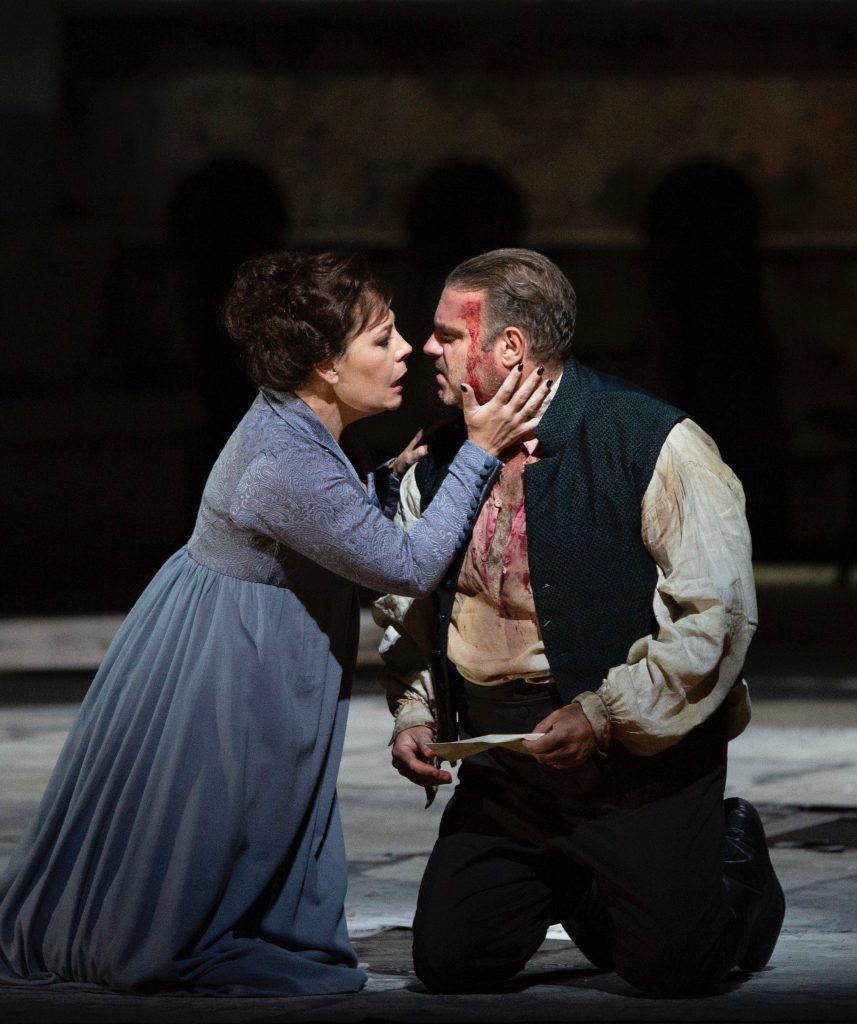With two blazing principals, Puccini’s “Tosca” ignites at the Met

Sondra Radvanovsky and Joseph Calleja in Puccini’s “Tosca” at the Metropolitan Opera. Photo: Marty Sohl
Grand and melodramatic, Tosca is in many ways the quintessential Italian tragic opera. And a great performance of it, such as the one that kicked off this season’s Metropolitan Opera revival Thursday night, is a prime example of the art form’s potential. Tosca at its best is a captivating, wrenching experience, a true marriage of music with drama, each enhancing the other.
Act II, in particular, is a marvel of construction, taut from beginning to end, its music framing the drama at the same time that it gives us a glimpse into the inner thoughts of the main characters—all of whom collide in a spectacular, cruel, violent confrontation at the Palazzo Farnese. On Thursday that scene thrilled, thanks to searing performances from the leads and exemplary work from the pit.
Sondra Radvanovsky’s last turn at the Met as Puccini’s legendary diva came in 2013. Her performance then was memorable, and her command of the role has only grown since then. Her Tosca is a woman of many layers: she is ferocious because circumstance demands it, getting down on the floor after stabbing Scarpia for a third time to taunt him with her famous barb, “E avanti a lui tremava tutta Roma,” almost whispered into his ear. But her scenes with her cherished Cavaradossi betrayed an innocent glee; even as Mario prepared for his date with the firing squad, she playfully demonstrated how he should fake his death when they fired their blanks.
Radvanovsky’s blazing soprano has lost none of its weight or power; it’s all fire, from top to bottom, and that she manages to control it enough to reflect the softer moments of Puccini’s vocal writing is itself a marvel. This was a shattering performance, and not a careful one: her “Vissi d’arte,” though sung with beautiful lyricism, was made all the more powerful by the boldness of her choices, often sacrificing technical precision for impact. Some rough attacks as she came down from the A at the top read as twinges of emotion finding their way into the vocal performance.
Joseph Calleja was no less impressive as the painter-turned-dissident Mario Cavaradossi. His take on the role is intense, reaching fierce, reckless passion in his defiant cries of “Vittoria!” as he taunts Scarpia over the news of Napoleon’s victory at Marengo. He was in top form vocally, showing a full, creamy tenor with a natural ring at the top. He gave an unusually nuanced reading of the Act III aria “E lucevan le stelle,” trusting in the melody’s emotional power without trying to oversell it.
Željko Lučić made a one-night-only appearance as Scarpia, replacing Wolfgang Koch, who withdrew last week due to illness (Claudio Sgura will sing the rest of the fall performances). He did not have his best voice, sounding smaller and a little more pale than usual. What he did have was his natural domineering presence: his Scarpia positively radiates malice, bringing a black cloud with him wherever he goes, providing a powerful foil for his fellow actors.
Strong performances in the supporting roles lent the performance extra depth. Oren Gradus showed a strong, woody bass in the role of the fugitive Angelotti, while Brenton Ryan was admirably slimy as Spoletta, Scarpia’s chief lackey. Patrick Carfizzi brought a colorful bass-baritone and terrific comedic instincts as the Sacristan.
This is the first revival of the David McVicar production that premiered on New Year’s Eve 2017, and there figure to be many more. The idealized portrayals of the three iconic locations in Rome (particularly Scarpia’s massive, gloomy office at the Palazzo Farnese) serve as apt settings for the high drama of Puccini’s most violent masterpiece.
The Met Orchestra bristled with dark power on Thursday, and one could hardly ask for a finer performance than that led by Carlo Rizzi. It was tight, precise, and perfectly balanced–but more than that, Rizzi absolutely captured the spirit of the piece, letting Puccini’s smoldering score drive the evening. He was not afraid to make strong choices, moving the tempo or reaching for extra volume where he thought the moment required it. This is a theatrical piece, after all, and calls for theatrical flair from the orchestra.
This Tosca is easily one of the most exciting offerings at the Met so far this season, and should be a priority on every calendar. For the opera-curious, it is an ideal demonstration of how powerful the art form can be. And for the seasoned addict, this is the sort of performance that keeps us coming back to the house night after night, hoping to catch something extraordinary.
Tosca runs through November 17 at the Metropolitan Opera. Claudio Sgura performs the role of Scarpia in the remaining fall performances, beginning October 29. A spring cast, starring Jennifer Rowley as Tosca and Wolfgang Koch as Scarpia, opens March 18, 2019 and runs through April 6. metopera.org







Posted Oct 28, 2018 at 12:49 pm by William S LLanes
As a young man I worked as an usher at the old Met and, to my delight through the years, many distinguished artists sang the role!
Most memorable was Callas’s return to the house for her last 2 performances in it.
Ms Sondra is a superb artist of present times!
Thank you